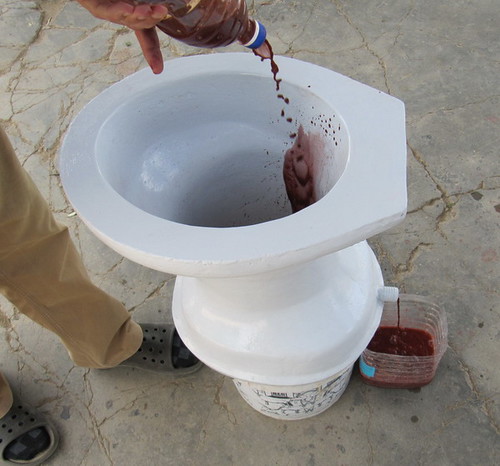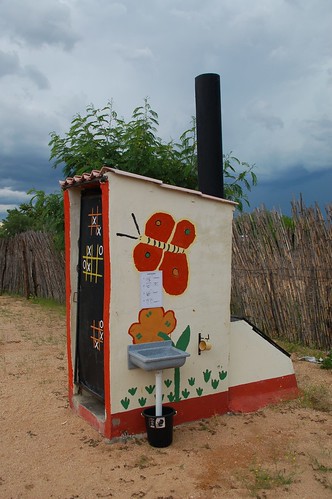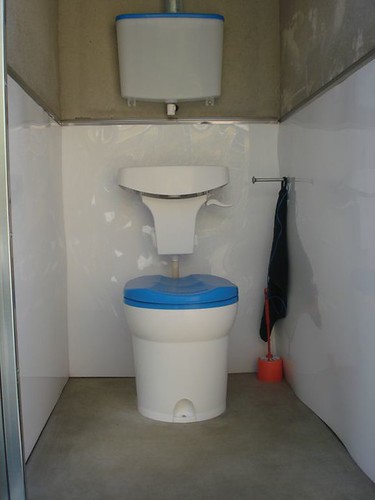- Sanitation systems
- Toilets with urine diversion
- UDDTs (urine-diverting dry toilets)
- Reseach Topic Assistance - Otji toilets (UDDTs) in Namibia
Reseach Topic Assistance - Otji toilets (UDDTs) in Namibia
20.8k views
- Elisabeth
-
- User is blocked
- Freelance consultant since 2012
Less- Posts: 3372
- Karma: 54
- Likes received: 932
Re: Design Suggestions for the Otji Toilet
Just to add on the interesting exchange about the Otji toilet in Namibia (thanks Chris and Peter!): You need to see some photos to know what they are talking about when they talk about a urine trough instead of the "normal" urine diversion in UDDTs.
This is what the urine trough looks like in a side view of a cut-off toilet pedestal:

Urine diversion bowl by Sustainable sanitation , on Flickr
And this is how the urine diversion works (the urine sticks to the side walls):

Urine diversion by Sustainable sanitation , on Flickr
This is what an Otji toilet may look like from the outside:

Kindergarten by Sustainable sanitation , on Flickr
Note that the same design of a urine trough for urine separation (where the user does not have to pay any particular attention!) is used by the South African company Amalooloo. In fact I suspect they were first and then the Otji toilet picked it up from them.
Photo of an Amalooloo toilet (but the urine diversion part is not visible here; not sure if this one is in fact with urine diversion):

Amalooloo August 2009 007 by Sustainable sanitation , on Flickr
This urine trough seems very smart to me. But I wonder why it has not been picked up more in other countries if it is a good design. There must be something wrong with it? Or just lack of marketing?
Regards,
Elisabeth
This is what the urine trough looks like in a side view of a cut-off toilet pedestal:

Urine diversion bowl by Sustainable sanitation , on Flickr
And this is how the urine diversion works (the urine sticks to the side walls):

Urine diversion by Sustainable sanitation , on Flickr
This is what an Otji toilet may look like from the outside:

Kindergarten by Sustainable sanitation , on Flickr
Note that the same design of a urine trough for urine separation (where the user does not have to pay any particular attention!) is used by the South African company Amalooloo. In fact I suspect they were first and then the Otji toilet picked it up from them.
Photo of an Amalooloo toilet (but the urine diversion part is not visible here; not sure if this one is in fact with urine diversion):

Amalooloo August 2009 007 by Sustainable sanitation , on Flickr
This urine trough seems very smart to me. But I wonder why it has not been picked up more in other countries if it is a good design. There must be something wrong with it? Or just lack of marketing?
Regards,
Elisabeth
Dr. Elisabeth von Muench
Freelance consultant on environmental and climate projects
Freelance consultant on environmental and climate projects
Please Log in to join the conversation.
You need to login to reply- rahulingle
-

- Moderator
Less- Posts: 107
- Karma: 2
- Likes received: 18
Dear Chris,
Thanks for your remarks on this paper. Here is the reply from Peter Arndt to your questions. I am posting it here on his behalf.
Since the urine trough apparently goes all the way around, it could receive watery diarrhea.
The inner edge of the urine trough is 10mm wider in radius than the edge of the toilet bowl. There is no direct vertical access to the trough. After passing the narrow section of the bowl the liquid must run along the then widening toilet walls. At this point the liquid must run along the wall upside-down, only be hold by adhesion forces against gravity. At the end of this upside-down running wall the liquid must then still “jump” from the edge over a 10mm gab in order to reach the trough. Experience have shown, that only pure liquid gains enough speed to jump over that gab while solid-liquid mix (diarrea) at that edge falls off vertical into the collecting container.
Why does the trough go all the way around, given that urine only comes forward?
The major benefit of our user-friendly design is that men can stand while urinating. While “sitters” mostly hit the front, “standers” will hit the toilet walls at any side but mostly at the back.
How was the 80% measured?
For this test two non perforated containers has cached liquid via the UDS-system as well as solid-liquid directly under the bowl. The solid-liquid container then has been filtrated in order to measure the liquid content. The amount of liquid at this solid-liquid container has been ¼ from the amount of the pure liquid container giving a 20% - 80% relation.
How often does this trough need to be cleaned? And how can this be done?
So far we have not observed the need to clean the through, since it cannot be reached from solid nor solid-liquid mix. However, the trough could easily be reach by hand with a gloss if needed.
How heavy are the containers when they are freshly filled and when they have dried for 6 month? Can they be easily lifted out by one person? Can the containers be easily reached without climbing in?
The 90l containers are tending to be too heavy for one person alone. The exactly weight of the containers are different due to different number of users and frequency. The sooner they are filled up the less time was given for dehydration with effects the weight. The containers are usually pulled out by two men using 1,6m hooks. Nobody has to climb in.
Are there raised points on the “basement” floor to assure that the active container is always pushed into the exactly right place?
It is relatively easy to place the active container in the right position since the position is easy to determine even without marks. There is sufficient tolerance given due to the wide opening of the container which is about double in diameter from the toilet bowl. In doubt one can have a look from top through the toilet bowl.
Is there a screen on the top of the chimney to keep flies out?
Experience in Namibia has shown that fly screens tend to get closed by dust and dirt very soon causing failure on ventilation effect. Therefore we rather do not use fly screens but still don’t experience significant increase on flies. The UDS-System in combination with an effective ventilation makes the Otji-Toilet unattractive for flies.
best regards
Rahul
Thanks for your remarks on this paper. Here is the reply from Peter Arndt to your questions. I am posting it here on his behalf.
Since the urine trough apparently goes all the way around, it could receive watery diarrhea.
The inner edge of the urine trough is 10mm wider in radius than the edge of the toilet bowl. There is no direct vertical access to the trough. After passing the narrow section of the bowl the liquid must run along the then widening toilet walls. At this point the liquid must run along the wall upside-down, only be hold by adhesion forces against gravity. At the end of this upside-down running wall the liquid must then still “jump” from the edge over a 10mm gab in order to reach the trough. Experience have shown, that only pure liquid gains enough speed to jump over that gab while solid-liquid mix (diarrea) at that edge falls off vertical into the collecting container.
Why does the trough go all the way around, given that urine only comes forward?
The major benefit of our user-friendly design is that men can stand while urinating. While “sitters” mostly hit the front, “standers” will hit the toilet walls at any side but mostly at the back.
How was the 80% measured?
For this test two non perforated containers has cached liquid via the UDS-system as well as solid-liquid directly under the bowl. The solid-liquid container then has been filtrated in order to measure the liquid content. The amount of liquid at this solid-liquid container has been ¼ from the amount of the pure liquid container giving a 20% - 80% relation.
How often does this trough need to be cleaned? And how can this be done?
So far we have not observed the need to clean the through, since it cannot be reached from solid nor solid-liquid mix. However, the trough could easily be reach by hand with a gloss if needed.
How heavy are the containers when they are freshly filled and when they have dried for 6 month? Can they be easily lifted out by one person? Can the containers be easily reached without climbing in?
The 90l containers are tending to be too heavy for one person alone. The exactly weight of the containers are different due to different number of users and frequency. The sooner they are filled up the less time was given for dehydration with effects the weight. The containers are usually pulled out by two men using 1,6m hooks. Nobody has to climb in.
Are there raised points on the “basement” floor to assure that the active container is always pushed into the exactly right place?
It is relatively easy to place the active container in the right position since the position is easy to determine even without marks. There is sufficient tolerance given due to the wide opening of the container which is about double in diameter from the toilet bowl. In doubt one can have a look from top through the toilet bowl.
Is there a screen on the top of the chimney to keep flies out?
Experience in Namibia has shown that fly screens tend to get closed by dust and dirt very soon causing failure on ventilation effect. Therefore we rather do not use fly screens but still don’t experience significant increase on flies. The UDS-System in combination with an effective ventilation makes the Otji-Toilet unattractive for flies.
best regards
Rahul
Best regards,
Rahul Ingle
Rahul Ingle
Please Log in to join the conversation.
You need to login to reply
Hi everyone,
I congratulate the designers, promoters, and builders of the Otji Toilet, described in the following excellent article.
www.susana.org/lang-en/library?view=ccbktypeitem&type=2&id=1608
(I read an earlier version and the current version could not open for some reason.)
The idea of diverting the urine via a trough going around the base of the pedestal is a creative solution, but raises some concerns.
Since the urine trough apparently goes all the way around, it could also receive watery diarrea.
Why does the trough go all the way around, given that urine only comes out forward?
How was the 80% measured?
How often does this trough need to be cleaned? And how can this be done?
A bench model would be easier and less expensive to build, with nearly no chance of fecal soiling, and more room for a urine funnel. It would also allow for easier access to the containers underneath, without the whole structure being so deep into the ground.
Other questions and comments:
How heavy are the containers when they are freshly filled and when they have dried for 6 months? Can they be easily lifted out by one person?
Can the containers be easily reached without climbing in?
Are there raised points on the “basement” floor to assure that the active container is always pushed into the exactly the right place?
Is there a screen on the top of the chimney to keep flies out?
The putting of dried feces into garbage dumps should be avoided as much as possible, both for recycling of the nutrients and for avoiding the filling of the dump. One of the promoting organizations could collect it for free for a certain time to demonstrate its safety and value in agriculture. It could potentially be stored for another 6 months, or it could be sanitized with the sun (see sanivation.org) and then applied to demonstration gardens. International (or urban Namibian) volunteers could be lined up to help with this demonstration and possibly attract more attention to the project.
I suspect that municipalities often choose to create a dependency on water and thus be able to charge more money from the population, together with associated taxes. Dry toilets, in contrast, increase people's independence and self-reliance. So this needs to be thought through politically also.
I would suggest a closed container for urine, with a hose reaching all the way down to the bottom, to control smell and nitrogen loss.
A bigger question is that Otji Toilets seem overly expensive to me, if the goal is to serve the millions of people who need toilets. A bench design would greatly reduce the overall size, cost, and ecological footprint of each unit.
Urine diversion via funnels made from post-consumer plastic bottles is entirely functional (especially with plastic mesh sewn into place to keep solids out). For years, I have been using 4-liter bottles (mainly those used to sell chlorine) and have recently switched to 6-liter PET water bottles, in order to create a bigger target (especially with respect to women). Nonetheless, urine diversion is more certain and complete in squatting models, in addition to the advantages in terms of reducing the incidence of hemorrhoids and constipation, improving hygiene, and making units more accessible to small children, plus the feces fall in a more orderly, vertical direction. This obviously opens up the bigger question of whether people want to squat ... or sit like the Queen of England.
((Please excuse a tangent: I would like to suggest to the English royal family that they consider joining us in promoting UDDTs and making a formal statement of the costs and benefits of the sit-down flush toilet they commissioned the invention of, in terms of cleanliness of palaces and cities, water pollution, and the non-sustainable transfer of nutrients to the rivers and oceans instead of respectfully returning them to the soil. At the same time, they could evaluate their contribution to Modern Western Society's excessive psychological distancing from Nature. Prince Charles is a great advocate of Nature Conservation, so maybe he would consider making such a statement. Are any Forum members friends of Prince Charles?))
I hope these comments are found to be useful.
Best wishes,
Chris Canaday
I congratulate the designers, promoters, and builders of the Otji Toilet, described in the following excellent article.
www.susana.org/lang-en/library?view=ccbktypeitem&type=2&id=1608
(I read an earlier version and the current version could not open for some reason.)
The idea of diverting the urine via a trough going around the base of the pedestal is a creative solution, but raises some concerns.
Since the urine trough apparently goes all the way around, it could also receive watery diarrea.
Why does the trough go all the way around, given that urine only comes out forward?
How was the 80% measured?
How often does this trough need to be cleaned? And how can this be done?
A bench model would be easier and less expensive to build, with nearly no chance of fecal soiling, and more room for a urine funnel. It would also allow for easier access to the containers underneath, without the whole structure being so deep into the ground.
Other questions and comments:
How heavy are the containers when they are freshly filled and when they have dried for 6 months? Can they be easily lifted out by one person?
Can the containers be easily reached without climbing in?
Are there raised points on the “basement” floor to assure that the active container is always pushed into the exactly the right place?
Is there a screen on the top of the chimney to keep flies out?
The putting of dried feces into garbage dumps should be avoided as much as possible, both for recycling of the nutrients and for avoiding the filling of the dump. One of the promoting organizations could collect it for free for a certain time to demonstrate its safety and value in agriculture. It could potentially be stored for another 6 months, or it could be sanitized with the sun (see sanivation.org) and then applied to demonstration gardens. International (or urban Namibian) volunteers could be lined up to help with this demonstration and possibly attract more attention to the project.
I suspect that municipalities often choose to create a dependency on water and thus be able to charge more money from the population, together with associated taxes. Dry toilets, in contrast, increase people's independence and self-reliance. So this needs to be thought through politically also.
I would suggest a closed container for urine, with a hose reaching all the way down to the bottom, to control smell and nitrogen loss.
A bigger question is that Otji Toilets seem overly expensive to me, if the goal is to serve the millions of people who need toilets. A bench design would greatly reduce the overall size, cost, and ecological footprint of each unit.
Urine diversion via funnels made from post-consumer plastic bottles is entirely functional (especially with plastic mesh sewn into place to keep solids out). For years, I have been using 4-liter bottles (mainly those used to sell chlorine) and have recently switched to 6-liter PET water bottles, in order to create a bigger target (especially with respect to women). Nonetheless, urine diversion is more certain and complete in squatting models, in addition to the advantages in terms of reducing the incidence of hemorrhoids and constipation, improving hygiene, and making units more accessible to small children, plus the feces fall in a more orderly, vertical direction. This obviously opens up the bigger question of whether people want to squat ... or sit like the Queen of England.
((Please excuse a tangent: I would like to suggest to the English royal family that they consider joining us in promoting UDDTs and making a formal statement of the costs and benefits of the sit-down flush toilet they commissioned the invention of, in terms of cleanliness of palaces and cities, water pollution, and the non-sustainable transfer of nutrients to the rivers and oceans instead of respectfully returning them to the soil. At the same time, they could evaluate their contribution to Modern Western Society's excessive psychological distancing from Nature. Prince Charles is a great advocate of Nature Conservation, so maybe he would consider making such a statement. Are any Forum members friends of Prince Charles?))
I hope these comments are found to be useful.
Best wishes,
Chris Canaday
Conservation Biologist and EcoSan Promoter
Omaere Ethnobotanical Park
Puyo, Pastaza, Ecuador, South America
inodoroseco.blogspot.com
Omaere Ethnobotanical Park
Puyo, Pastaza, Ecuador, South America
inodoroseco.blogspot.com
The following user(s) like this post: Elisabeth
Please Log in to join the conversation.
You need to login to reply
Share this thread:
- Sanitation systems
- Toilets with urine diversion
- UDDTs (urine-diverting dry toilets)
- Reseach Topic Assistance - Otji toilets (UDDTs) in Namibia
Recently active users. Who else has been active?
Time to create page: 0.142 seconds








